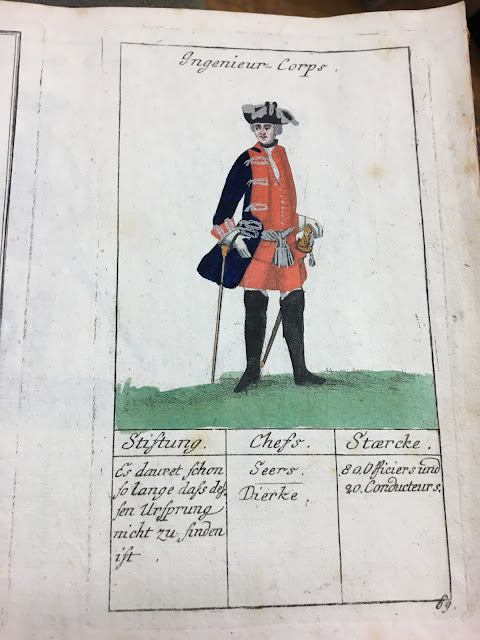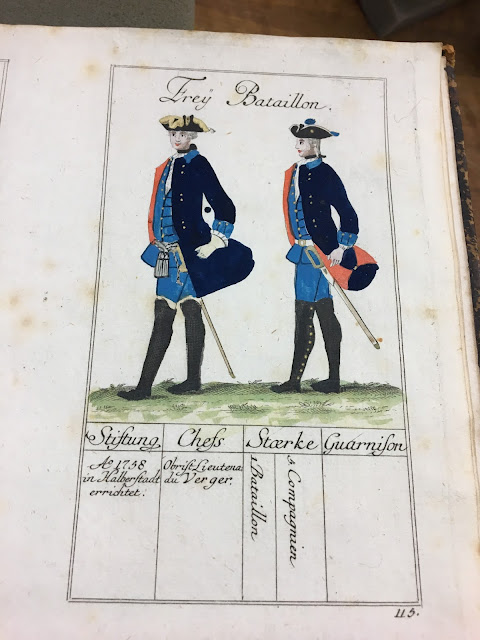 |
| The British Prepare to Give Fire |
Dear Reader,
After the post last week on ammunition expenditure, I noted a number of surprised conversations on social media. If many eighteenth-century battles in Europe, and some in North America, resulted in troops expending their ammunition load (of 30, 40, 60, or 90+ rounds) how could any soldiers be left alive? Or in other words, in battles with such high rates of ammunition expenditure, how could casualties be so low?
The answer to this riddle is not the supposed inaccuracy of muskets, or the failure of soldiers to aim properly, but the ranges at which battles were often fought. When picturing eighteenth-century combat, historians and the public often imagine battle reenactments. In these reenactments, troops often open fire at a very short range, at say 50 or 25 yards. For those unused to picturing such ranges, imagine one half or one-quarter of an American football field. Troops in the eighteenth-century occasionally fired at such close range (such as the Swedish Karoliner of the Great Northern War) but MUCH more frequently, fire-fights developed at a longer range.
 |
| Reenactors represent Regiment von Bose at Guilford Courthouse |
In the eighteenth-century, the term "musket-shot" usually referred to a distance of around 300 yards. Commanders, concerned about the accuracy of their musketry, often performed tests in peacetime to discover an optimal range. During the era, such tests were conducted at between 500 yards and 80 yards, 200 yards and 100 yards, and further estimations of 250 yards and 80 yards and 200 yards and 80 yards.[1] I find it strangely compelling that none of these tests felt the need to practice at ranges underneath 80 yards, perhaps implying that combat infrequently reached those close distances. Leaving aside this theoretical point, let us turn to what the soldiers of the era say in their writings: how close range were eighteenth-century firefights?
Although there is no way to truly measure the surviving descriptions of range scientifically, we can perhaps arrive at a few conclusions regarding the range of eighteenth-century firefights. In the first category, there are skirmishes and premature fires by inexperienced troops. These preliminary skirmishes often occurred at 300 yards, or even a greater distance. As a result, they were not very deadly. During skirmishes in 1759 and 1760, French troops and their native allies opened fire on the British at a range of 300 yards, which seemed quite normal to the participants.[2] During a skirmish on Staten Island in June of 1777, preliminary skirmishing began at about 300 yards.[3] At the Battle of Mollwitz in 1741, the Prussian infantry, inexperienced in real combat, opened fire at the considerable range of 600-800 yards.[4]
 |
| A small group of Prussians engaged in a firefight |
In Europe during large-scale and determined combat, battle-lines could draw much closer. A good "average" range for combat during the Seven Years' War appears to be between 200 yards and 100 yards. At the Battle of Leuthen in 1757, Ernst von Barsewisch recalled, "As soon as we had cleared the forest, we approached the enemy's second line of battle at a distance of 200 paces [150 yards], which was preparing to march against us. Now... our officers ordered, "Fire! Fire!"[5] Later in the war, Barsewisch recalled being fired on by Croats at a similar distance.[6] The battle lines at Prague in 1757 appear to have been around 150 yards apart.[7] At Hochkirch in 1758, Johann von Archenholz recalled that the Austrians opened fire at, "a few hundred paces."[8] During a skirmish near Prenzlow in October of 1760, hostile forces approached to within 200 paces [150 yards] of one another.[9] At the Battle of Vellinghausen in 1761, official reports indicate that battle lines were 150 paces [100 yards] apart, and indicate that this was uncomfortably close.[10] By contrast, when the battle lines closed to 80 yards at the Battle of Minden, the contest was no longer in doubt, and the French began to retreat.[11]
In North America, infantry firefights followed a similar mold. Although the French and Indian War saw few large-scale field battles, a few sources describe infantry firefights. At the Battle of the Plains of Abraham, the French opened fire a very regular European distance, 130 yards.[12] During fighting in the Carribean in 1759, Francis Downman noted that the enemy moved away from the British, "keeping always 200 yards in our front."[13] During the American War of Independence, firefights continued to follow a European pattern, at least with regards to range. During the flank attack at the Battle of Brandywine, both the British and Americans gave fire at 150 yards, and then the British immediately charged at the run with their bayonets.[14] The French attack on St. Lucia in December of 1778 was conducted, "at a distance not less than 280 yards."[15] At the Battle of Camden, John Robert Shaw describes an infantry firefight at 100 yards.[16] At Guilford Courthouse, Roger Lamb reports that the American line opened fire at 140 yards.[17] Berthold Koch, a sergeant with the Von Bose Regiment, recalled receiving fire at 100 yards from the American line.[18]
 |
| British Reenactors representing the 2nd Battalion of Light Infantry |
Troops were often ordered to hold their fire until very close to the enemy line, but appear to have found it difficult to follow this directive. At the Battle of Germantown in 1777, Joseph Plump Martin describes this in his humorous way:
"Our brigade moved off to the right into the fields. We saw a body of the enemy drawn up behind a rail fence on our right; we immediately formed in line and advanced upon them. Our orders were not to fire till we could see the buttons upon their clothes, but they were so coy that they would not give us an opportunity to be so curious, for they hid their clothes in fire and smoke before we had either time or leisure to examine their buttons."[19]Here, we find a unit ordered to hold fire until close to the enemy, but because the enemy began returning fire a long range, a longer ranged firefight developed. When troops did approach (or fire) at ranges closer than 100 yards, it was often because a bayonet attack was underway. The Swedish Army in the Great Northern War, and the British Army in the American War of Independence, both made quick moving assaults supported by one close-range volley a standard of their tactical repertoire. Nicholas Creswell describes this type of attack on Staten Island in 1777:
When [the two sides] were about 100 yards from each other, both parties fired, but I did not see any fall. They still advanced to the distance of 40 yards or less and fired again. I then saw a great number fall on both sides. Our people rushed upon them with their Bayonets and the others took to their heels. I heard one of them call out murder lustily, this [would have been] laughable if the consequence was not serious. A Fresh party immediately fired upon our people but was dispersed and pursued into the woods by a company of the 15th Regmt."[20]
 |
| British Troops. The man in front appears to be calling out, murder, lustily. |
Here, Nicholas Creswell describes the archetypal bayonet attack as practiced by the British Army in the American War of Independence. If troops moved into 50 yards or closer, it was not to have an extended firefight, but because one or other intended to make an attack with bayonets, or was in the process of doing so. Some British commanders may have preferred try and close the distance before firing. Prescriptive source: drill manuals, books offering advice to officers, etc, often instructed soldiers to reserve their fire until at thirty or fifty yards of the enemy.[21] Often, the commanders judged their tactics on a case-by-case basis. At the Prussian 1785 Review, British General Cornwallis criticized Prussians for advancing too close to their mock enemies before opening fire.[22] While a good idea in theory, advancing into such close range under a heavy fire proved difficult to do. Notably, the British seem to have achieved this at the Battle of the Plains of Abraham, but examples of this kind are rare. On average, troops seem to have fired at ranges of 100 yards or longer.
How might reenactors represent this to the public? Battles should occur at greater ranges. If you are engaged in a standup firefight with other reenactors, and you are much closer than 75 yards away, something is wrong. If the British advance to within 40 yards and fire a volley, they should immediately follow that volley with a bayonet attack and either way, Continental forces should quickly prevail or retreat. Engaging in standup firefights with 20+ rounds expended is acceptable, even laudable. Just make sure that you have a football field or two between you and the opposing forces while doing so.
If you enjoyed this post, or any of our other posts, please consider liking us on facebook, or following us on twitter. Consider checking out our exclusive content on Patreon. Finally, we are dedicated to keeping Kabinettskriege ad-free. In order to assist with this, please consider supporting us via the donate button in the upper right-hand corner of the page. As always:
Thanks for Reading,
Alex Burns
--------------------------------------------------------------------------------------------------------------------------
[1] Duffy, Military Experience in the Age of Reason, 207.; The Army of Frederick the Great, 128.; Lossow, Denkwürdigkeiten, 260-61, 275.
[2] John Knox, An Historical Journal, Vol 2, 274.; Vol 1, 305.
[3] Nicholas Creswell, A Man Apart, 170.
[4] Valorie, Quoted in Duffy, Military Experience, 212.
[5] Barsewisch, Meine Kriegs-Erlebnisse, 36.
[6] Ibid, 170.
[7] Johann von Archenholz, Geschischte des Siebenjährige Kriegs , (1911, Leipzig), 52.
[8] Ibid, 187.
[9] Sammlung ungedruckter Nachrichten, Vol 5, 358.
[10] Westfalen, Geschichte der Feldzüge des Herzogs Ferdinand, Vol 5, 623.
[11] Ibid, Vol 3, 486.
[12] Knox, Journal, 70. (The British, it must be said, held their fire until 40 yards on this occasion).
[13] Francis Downman, The Services of Lt. Colonel Francis Downman, 8.
[14] Martin Hunter, Extracts from the Journal of General Sir Martin Hunter, 27.
[15] Downman, The Services, 98.
[16] John Robert Shaw, John Robert Shaw, 31.
[17] Roger Lamb, An Original and Authentic Journal, 350.
[18] Bertold Koch, The Battle of Guilford Courthouse, 7.
[19] Joseph Plumb Martin, Private Yankee Doodle, 72-73.
[20] Creswell, A Man Apart, 170-171
[21] David Blackmore, Destructive and Formidable, 136-137
[22] Charles Cornwallis, Correspondence of Charles, first Marquis Cornwallis, Vol 1, 211.





























































